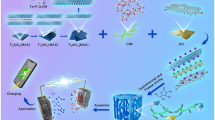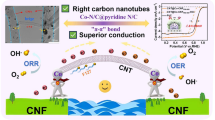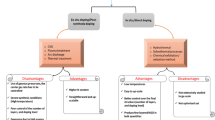Abstract
We demonstrated direct deposition a porous conducting polymer poly(3,4-ethylenedioxythiophene) (PEDOT) nanostructure on reduced graphene oxide (RGO) as high performance electrochemical electrode. The large area RGO film was constructed on substrate through a Langmuir–Blodgett deposition of graphene oxide and a following reductive treatment. The porous PEDOT nanostructure was successively constructed on RGO through an in situ solution polymerization and simple thermal treatment. This porous PEDOT/RGO nanocomposites contained large and highly opened surface area with superior electrochemical activity. A specific capacitance as high as 267 F/g at a current density of 0.5 A/g was achieved. The compared conductive performance between RGO and porous PEDOT resulted in better EIS performance of composite electrode. The stable covering of porous PEDOT on RGO also improved the capacitance retention performance of PEDOT, and the nanocomposites showed excellent capacitance retention rate after 4,000 charge/discharge cycles. The research data revealed that high specific capacitance and good cycling stability can be achieved either by coupling the advantages of carbon materials and conducting polymer.








Similar content being viewed by others
References
L. Xia, Z.X. Wei, M.X. Wan, Conducting polymer nanostructures and their application in biosensors. J. Colloid Interface Sci. 341, 1 (2010)
D. Li, J.X. Huang, R.B. Kaner, Polyaniline nanofibers: a unique polymer nanostructure for versatile applications. Acc. Chem. Res. 42, 135 (2009)
H.D. Tran, D. Li, R.B. Kaner, One-dimensional conducting polymer nanostructures: bulk synthesis and applications. Adv. Mater. 21, 1487 (2009)
G.A. Snook, P. Kao, A.S. Best, Conducting-polymer-based supercapacitor devices and electrodes. J. Power Sources 196, 1 (2011)
W.U. Huynh, J.J. Dittmer, A.P. Alivisatos, Hybrid nanorod-polymer solar cells. Science 295, 2425 (2002)
M. Mastragostino, C. Arbizzanib, F. Soavia, Conducting polymers as electrode materials in supercapacitors. Solid State Ion. 148, 493 (2002)
K.S. Ryu, K.M. Kim, N.G. Park, Y.J. Park, S.H. Chang, Symmetric pedox supercapacitor with conducting polyaniline electrodes. J. Power Sources 103, 305 (2002)
K. Wang, J.Y. Huang, Z.X. Wei, Conducting polyaniline nanowire arrays for high performance supercapacitors. J. Phys. Chem. C 114, 8062 (2010)
S. Cho, S.B. Lee, Fast electrochemistry of conductive polymer nanotubes: synthesis, mechanism, and application. Acc. Chem. Res. 41, 699 (2008)
P. Simon, Y. Gogotsi, Materials for electrochemical capacitors. Nat. Mater. 7, 845 (2008)
K. Wang, Q.H. Meng, Y.J. Zhang, Z.X. Wei, M.H. Miao, High-performance two-ply yarn supercapacitors based on carbon nanotubes and polyaniline nanowire arrays. Adv. Mater. 25, 1494 (2013)
Y. Zhou, Z.Y. Qin, L. Li, Y. Zhang, Y.L. Wei, L.F. Wang, M.F. Zhu, Polyaniline/multi-walled carbon nanotube composites with core-shell structures as supercapacitor electrode materials. Electrochim. Acta 55, 3904 (2010)
K. Zhang, L.L. Zhang, X.S. Zhao, J.S. Wu, Graphene/polyaniline nanofiber composites as supercapacitor electrodes. Chem. Mater. 22, 1392 (2010)
Q. Wu, Y.X. Xu, Z.Y. Yao, A.R. Liu, G.Q. Shi, Supercapacitors based on flexible graphene/polyaniline nanofiber composites films. ACS Nano 4, 1963 (2010)
E. Frackowiak, Carbon materials for supercapacitor application. Phys. Chem. Chem. Phys. 9, 1774 (2007)
L.L. Zhang, X.S. Zhao, Carbon-based materials as supercapacitor electrodes. Chem. Soc. Rev. 38, 2520 (2009)
S. Bose, T. Kuila, A.K. Mishra, R. Rajasekar, N.H. Kim, J.H. Lee, Carbon-based nanostructured materials and their composites as supercapacitor electrodes. J. Mater. Chem. 22, 767 (2012)
G.M. Suppes, B.A. Deore, M.S. Freund, Porous conducting polymer/heteropolyoxometalate hybrid material for electrochemical supercapacitor applications. Langmuir 24, 1064 (2008)
L.L. Zhang, X. Zhao, M.D. Stoller, Y.W. Zhu, H.X. Ji, S. Murali, Y.P. Wu, S. Perales, B. Clevenger, R.S. Ruoff, Highly conductive and porous activated reduced graphene oxide films for high-power supercapacitors. Nano Lett. 12, 1806 (2012)
G. Eda, G. Fanchini, M. Chhowall, Large-area ultrathin films of reduced graphene oxide as a transparent and flexible electronic material. Nat. Nanotech. 3, 270 (2008)
Y. Chen, X. Zhang, D.C. Zhang, P. Yu, Y.W. Ma, High performance supercapacitors based on reduced graphene oxide in aqueous and ionic liquid electrolytes. Carbon 49, 573 (2011)
J.F. Shen, Y.Z. Hu, M. Shi, X. Lu, C. Qin, C. Li, M.X. Ye, Fast and facile preparation of graphene oxide and reduced graphene oxide nanoplatelets. Chem. Mater. 21, 3514 (2009)
S.F. Pei, H.M. Cheng, The reduction of graphene oxide. Carbon 50, 3210 (2012)
O.C. Compton, S.T. Nguyen, Graphene oxide, highly reduced graphene oxide, and graphene: versatile building blocks for carbon-based materials. Small 6, 711 (2010)
I. Jung, D.A. Dikin, R.D. Piner, R.S. Ruoff, Tunable electrical conductivity of individual graphene oxide sheets reduced at “Low” temperatures. Nano Lett. 8, 4283 (2008)
J.T. Zhang, X.S. Zhao, Conducting polymers directly coated on reduced graphene oxide sheets as high-performance supercapacitor electrodes. J. Phys. Chem. C 116, 5420 (2012)
N.A. Kumar, H.J. Choi, Y.R. Shin, D.W. Chang, L.M. Dai, J.B. Baek, Polyaniline-grafted reduced graphene oxide for efficient electrochemical supercapacitors. ACS Nano 6, 1715 (2012)
M.Q. Xue, F.W. Li, J. Zhu, H. Song, M.N. Zhang, T.B. Cao, Structure-based enhanced capacitance: in Situ growth of highly ordered polyaniline nanorods on reduced graphene oxide patterns. Adv. Funct. Mater. 22, 1284 (2012)
D.Y. Cai, M. Song, Recent advance in functionalized graphene/polymer nanocomposites. J. Mater. Chem. 20, 7906 (2010)
T. Kuilla, S. Bhadra, D.H. Yao, N.H. Kim, S. Bose, J.H. Lee, Recent advances in graphene based polymer composites. Prog. Polym. Sci. 35, 1350 (2010)
L.L. Zhang, S.Y. Zhao, X.N. Tian, X.S. Zhao, Layered graphene oxide nanostructures with sandwiched conducting polymers as supercapacitor electrodes. Langmuir 26, 17624 (2010)
C.G. Liu, Z.N. Yu, D. Neff, A. Zhamu, B.Z. Jang, Graphene-based supercapacitor with an ultrahigh energy density. Nano Lett. 10, 4863 (2010)
T.H. Han, Y.K. Huang, A.T.L. Tan, V.P. Dravid, J.X. Huang, Steam etched porous graphene oxide network for chemical sensing. J. Am. Chem. Soc. 133, 15264 (2011)
J.F. Wen, Y.D. Jiang, Y.J. Yang, S.B. Li, Conducting polymer and reduced graphene oxide Langmuir-Blodgett films: a hybrid nanostructure for high performance electrode applications. J. Mater. Sci.: Mater. Electron. 25, 1063 (2014)
Acknowledgments
The work was supported by the National Science Foundation of China (NSFC) (Nos. 61101029, 51477026 and 61204098), A Plan for Supporting the New Century Talents (No. NCET-12-0091).
Author information
Authors and Affiliations
Corresponding author
Rights and permissions
About this article
Cite this article
Yang, W., Xu, J., Yang, Y. et al. Porous conducting polymer and reduced graphene oxide: preparation, characterization and electrochemical performance. J Mater Sci: Mater Electron 26, 1668–1677 (2015). https://doi.org/10.1007/s10854-014-2591-x
Received:
Accepted:
Published:
Issue Date:
DOI: https://doi.org/10.1007/s10854-014-2591-x




